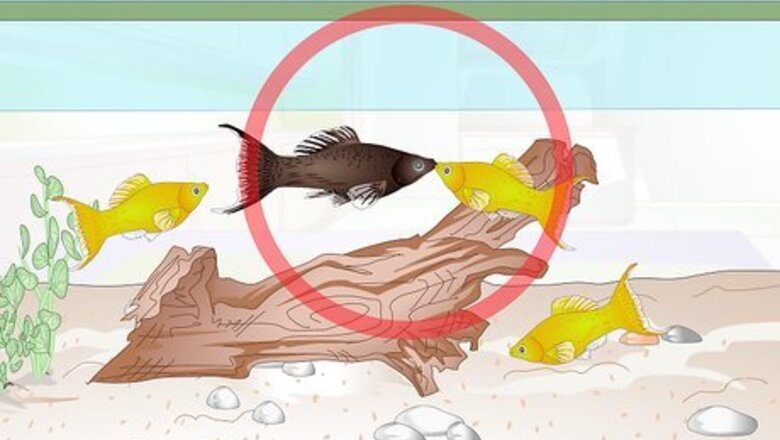
views
Creating a Beneficial Breeding Environment for Mollies

Allow the fish to mate with one another. Mollies are hierarchical fish. Whichever male has the biggest fins and boldest colors leads the way. This means the ideal combination of male and female fish is one male for multiple females. You may see the male under the female; this is how the fish copulate. If their mating is successful, their babies should be born in about 3 to 5 weeks.
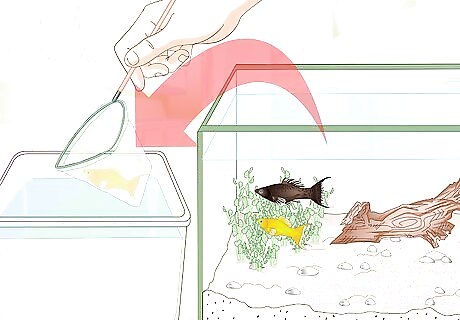
Remove the female from the aquarium before birthing begins. Place the female in a separate “nurser” tank if possible. The male fish often chases around the female, wishing to copulate more, and this could cause stress on the pregnancy. You’ll be able to tell the molly is pregnant by a very distended belly. If the “nurser” tank is not possible, consider using an aquarium net breeder, which is essentially a mesh cube with plastic edges, to protect the mother and baby fish. Removing the mother from the main aquarium is also to protect the fry. Molly fish often cannibalize their babies. Don’t wait too close to the birth date. Stressed mollies may have more aborted births and stillborn.
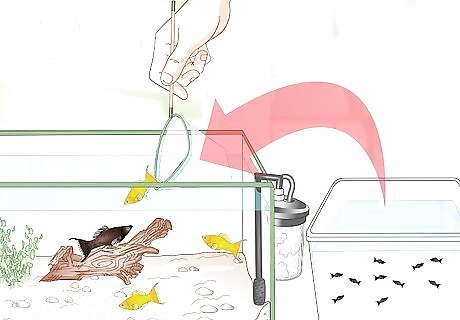
Reintroduce the female into the main aquarium. The female may eat her own young, so it’s best to move her back with the other fish for the safety of the fry. Roughly once per month, however, the mother may need to be re-segregated since female molly fish can retain multiple fertilized eggs for nearly half a year.
Caring for the Fry
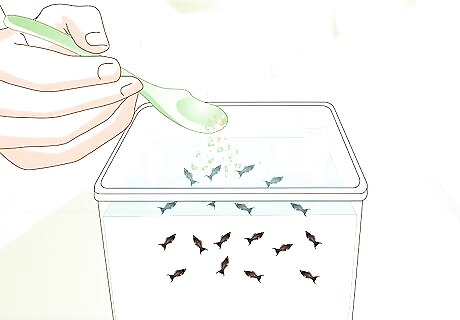
Feed the fry. Use ground fish food of the same type that you feed to your adult mollies. Flake food should be used as a primary base. Supplement the normal meals with a broad variety of denser meals. Various worms are great for molly fish. Grindal worms, black worms, and blood worms work well. Brine shrimp, live or frozen, are a preferred source of food. Molly fish even eat algae, which is their primary food in the wild.

Wait for the fish to mature. It will take around nearly two months to be able to tell males and females apart. Once they’ve doubled in size, it’s probably safe to introduce them into the main tank with the rest of the fish. Another good way to tell if they’re safe to interact with the other fish is if they are too big to fit into the other fishes mouths.
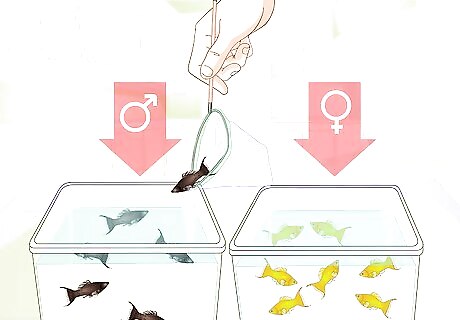
Separate the males and the females. Once you know the gender of the mollies, you'll need to ensure more breeding doesn't take place. They will, in fact, breed between brothers and sisters. Try to separate the male and female fish before they are eight weeks old, which is when they reach sexual maturity.
Ensuring You Have the Right Setup to Breed Mollies

Purchase an aquarium/tank. You'll need a tank that holds around 15g – 30g water (56L-113L). In general, molly fish do better with larger fish tanks and more room to swim around. Smaller tanks may create a variety of problems: Less swimming room to get away from aggressive fish, which creates stress Harder to clean, which can lead to sickness

Place any decorations in the aquarium. Choose such decorations as rocks, air filters and decorative gravel. In general, molly fish should have enough room to swim around quite freely, but also enough decorations to hide from bully fish. The less aggressive fish will more around in the tank to hide from bully fish. If there aren’t enough hiding spots, the fish could become stressed.

Anchor freshwater plants below the substrate. The substrate should provide the base to your tank, but also serve potential nutrients to any plants inside the aquarium. In general, the substrate should be comprised of two levels: The top level should be 2 inches of something sturdy, like sand, pebbles, or gravel. The bottom level should be 1-2 inches of nutrient-rich material.
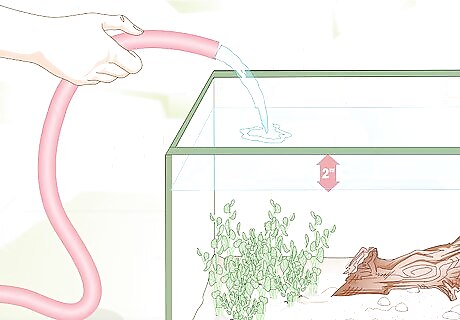
Fill the tank with water near the top. Up to 2 inches (4cm) under the brim of the tank is ideal. The water should be warm – 78-82° F (25-27° C) – so the molly fish are comfortable, like they would be in tropical waters. Do not overfill the tank or put in cold water. An aquarium heater will probably be necessary. Replace water on a fairly regimented schedule. Daily minimal water changes, or up to 30% per week, are recommend.
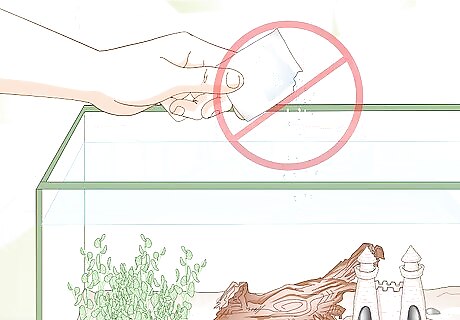
Avoid aquarium salt. Some molly fish are brackish, which means they have a varying requirement for freshwater and saltwater. There is a fairly large debate, however, about whether or not they need marine salt in the aquarium. Some experts contend most molly fish never see salty or brackish waters, and it’s not necessary for the water. Some sources indicate that approximately one Tbsp per five gallons of water is good. The addition of salt may act as a healing attribute, a way to overcome slightly dirty water. If you buy an exotic breed of molly, you may want to consult with an expert to be sure you can go completely without salt.
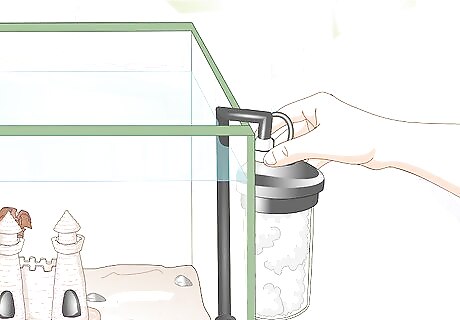
Install the filter according to the instructions. Ultimately, the water should have a fairly neutral pH level between 7 and 8. Some experts recommend increasing the pH by just a bit, to 8.4 After the tank is filled, adjustments to the filter and water may be necessary.
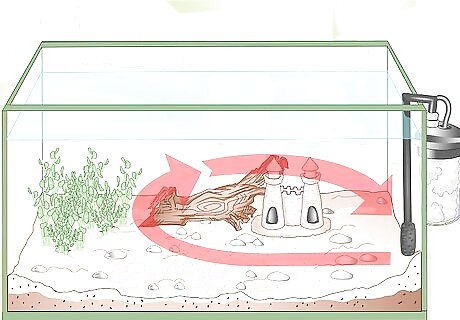
Allow the tank to cycle before adding the fish. It is best to allow the tank to cycle, because the water is lacking beneficial bacteria, which leaves fish susceptible to illness and disease. Carefully monitor your aquarium if you can't wait before adding your fish.

Choose how many mollies you want. Generally, a good fit for the fish is a couple mollies per 10 gallon tank. They need ample room to swim around and, if you end up with multiple fry, room to hide from the more aggressive fish. If you want more than just a couple, you should use the recommended larger tank.

Purchase your mollies. Go to your local pet store and pick male and female fish. While there are several varieties of molly fish, they are extremely easy to breed because all colors are the same species, and all males and females breed with one another. Some recommend getting the subspecies of mollies for quicker breeding. You can ask the employees at the store for help, or you can do it yourself. Male molly have a gonopodium, a long stick-like fin used to fertilize the female, on his lower half. Female molly have a softer, fan-shaped anal fin, which is also on the lower half of the body.

Transfer your fish to the tank. When acclimating new fish into the aquarium, float the bag in the tank for 15 minutes to adjust the temperature. Open the bag and add the tank water to the bag every 5 minutes for an additional 15 minutes—about a ⁄8 c (30 mL) cup in total will do. Then, test the pH of the bag water and compare it to the pH of the existing aquarium. The bag water and aquarium should have the same pH before you add the new fish. The fish is supposed to be introduced to the pH while it's still in the bag. It's best to turn the aquarium lights off to reduce stress on new fish.




















Comments
0 comment